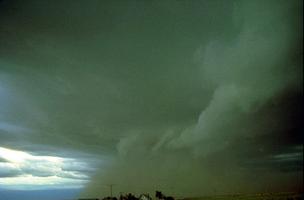
Agricultural Soil Practices
Agricultural soil practices Development and management of Soil Resources for agricultural production requires consideration of land-clearing methods, Soil and Crop practices (including Erosion control) and environmental impact. Development of land for agriculture frequently requires the clearing of brush-covered or forested land. Such clearing aims to remove unwanted material efficiently and economically, to minimize topsoil displacement and degradation, and to leave a seedbed sufficiently well cleared and graded to allow use of cultivating, planting and harvesting equipment. Methods selected for surface clearing depend on the nature, density and extent of the cover Vegetation.
Harvesting of marketable timber, if present, constitutes the first stage and may involve individual trees or a stand. Logs may be cut, stripped and piled with tree harvesters; trees may be knocked down, lifted and moved with tree-dozers. Stumpers are often preferred to bulldozers for removing stumps and large stones as they minimize the effect on topsoil. Heavy-duty bar mowers, rotary brush mowers and brush beaters are used to cut, chop and shred brush. When such a device produces a mulch, trash disposal is eliminated. Selective herbicides are used to remove specific plant species; nonselective or contact herbicides, for defoliation. Plants with deep root systems are removed with an undercutting or root-cutting and clearing implement. Soil is cleared to below plowing and cultivation depths. Root rakes and similar specialized equipment allow thorough combing of surface-cleared areas to remove roots, stump fragments, small brush and undergrowth. Final finishing is done with heavy disc plows and harrows; land levellers are used where grading is required for improved drainage.
Soil and Crop Practices
Establishment of an agricultural program requires careful selection of soil and crop management practices to optimize long-term yields while minimizing soil loss, compaction and degradation. Throughout Canada the erosion of topsoil and subsoil is increasing. Cropping practices dependent on continuous cultivation of a single crop have also precipitated soil degradation across the country.
Water Erosion
Sheet and rill erosion occur in fields as a result of improper soil and crop management, erodible soil conditions, and excessive surface drainage and field runoff. Spring snowmelt and summer convective storms in western Canada cause most damage. Upland cultivated soils across Canada are subject to soil loss by sheet, rill and gully erosion. Conservation tillage and cropping systems provide the most cost-effective remedial measures. Terraces can be used to form a series of diversions down a slope or to change a steep slope to a series of gentler slopes.
Grassed waterways can be developed on sloping cultivated areas where surface runoff concentrates or where it has produced severe rill damage. These waterways may also be used as outlets for contour strips or contour diversions. Concentrated surface flows can lead to gully formation; water seepage out of the developed banks often aggravates this problem. Small gullies can be regraded and revegetated, but larger ones may require installation of surface diversions (to divert runoff laterally from the slope), check dams (to slow velocity of concentrated flow) or drop structures (eg, rock chutes, subsurface drop inlets, surface drops). Seepage drains can be installed in banks to control sloughing and bank mining (see Farm Drainage).
Wind Erosion
results in serious soil loss where inappropriate soil and crop management systems are used, where fields are exposed to an extensive wind run, or where topographic features are vulnerable. Late winter and early spring are critical seasons in western Canada, where as much as 30% of cultivated land is left fallow and, thus, is subject to wind erosion. Land-management systems for Soil Conservation include keeping the surface of soils in a rough condition (eg, by minimizing tillage operations); keeping vegetation, residue and trash on the surface; using manures, green manures and crop rotations; cropping and strip-cropping at right angles to the prevailing wind; and providing wind barriers (eg, tree shelterbelts, grass strips, fence rows).
Streambank and Ditchbank Erosion
can be caused by water running over the surface of the bank on its way to the drainageway or stream, by soil instability resulting from subsurface seepage or other locally high soil-water conditions, by shear stresses imposed on the bank by the stream flow, and by land-management activities (eg, pasturing animals on banks, cultivating land immediately adjacent to banks). In a recent inventory of agricultural watersheds in Ontario, erosion is shown as occurring on 37% of the banks and rotational slumping on 25%. Such problems can be controlled with revegetation, runoff diversions, vegetated buffer strips and drop structures. Soil stability problems can be alleviated with regrading and revegetation, bank drainage, limiting animal access and constructing retaining walls. Problems linked to high stream velocities or localized turbulence can be controlled with vegetative and rock riprap linings. More serious problems require gabions, or asphalt linings.
Accelerated soil erosion on fields and banks causes damage not only in the immediate area but also downstream, as the transported soil particles clog stream channels, silt ponds and reservoirs, or cover fish-spawning beds. Where the capacity of a channel is reduced by sedimentation, flood waters may be forced to reroute overland. Agricultural sediments can be transport agents for potential contaminants (eg, phosphorus, heavy metals, herbicides). Suspended solids can be controlled at the erosion source or in the flow system. Sediment traps at field drainage outlets or in waterways are used to intercept sediment-laden surface runoff.

 Share on Facebook
Share on Facebook Share on X
Share on X Share by Email
Share by Email Share on Google Classroom
Share on Google Classroom


